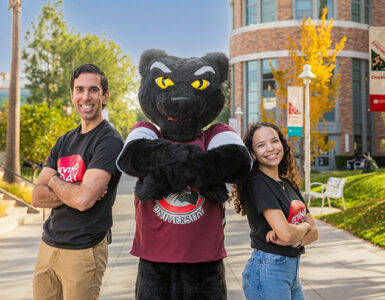The fires keep coming, along with heartbreaking images of lives, homes and communities destroyed. So it’s understandable that well-meaning people want to launch a clothing drive, collect shoes or dash to the communities to lend a hand.
But don’t do it.
At least not yet, say Chapman University faculty who teach and study the best practices of disaster relief and assistance. Relief organizations and government agencies typically have their hands full with immediate health and safety issues, says Chris Hutchison, Ph.D., assistant dean of students, who along with Justin Koppelman, Ph.D., associate director of civic engagement initiatives, teaches the course Leadership in the Eye of the Storm.
“It takes a tremendous amount of energy from those agencies to prepare volunteers. If we overwhelm them with volunteers … that’s going to take time and money away from that they need to do,” Hutchison says.
For Now, Donate
In the short term, donate money to well-vetted emergency relief agencies that have the expertise, equipment and trained volunteers ready to go, says Koppelman. Research your charities of choice at Charity Navigator.
Here are some options to consider:
- California Community Foundation, fund for wildfire relief in Northern and Southern California as well as support for victims of the Thousand Oaks mass shooting: https://www.calfund.org/
- United Way of Northern California, fund for Camp Fire relief. To donate, text BUTTEFIRE to 91999 or Click Here.
- Bay Area professional sports teams have established a You Caring site in partnership with the American Red Cross Disaster Relief: https://www.nba.com/warriors/news/bay-area-teams-donate-north-bay-fire-20171011
- United Way of Greater Los Angeles, fund for Hill and Woolsey fire relief: https://www.unitedwayla.org/en/give/disaster-relief-fund/
- Los Angeles County Animal Care Foundation for displaced animals, specific Noah’s Legacy fund on giving form: https://lacountyanimals.org/give/
- California Fire Foundation, provides victim assistance: http://www.cafirefoundation.org/programs/supplying-aid-to-victims-of-emergency/
Hands-On Help Comes Later
Soon enough the call for hands-on help will come – and probably keep coming. For example, the rebuilding of New Orleans after Hurricane Katrina continues, Koppelman says. Each spring a long list of tasks awaits the Chapman community service teams that collaborate with Rebuilding Together New Orleans.
People who work on such efforts also need to be ready to shift their energies, because needs change as recovery work moves from short-term to ongoing concerns, he says. He points to New Orleans as a complex case study still in progress.
“So many people ended up being dispersed by Katrina,” he says. “Now people are making decisions about the rebuilding of New Orleans. In the longer term it’s important to work to make sure their voices, their interests and their needs are reflected.”




